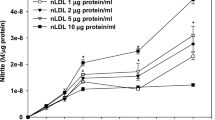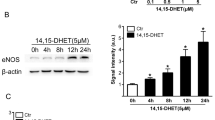Abstract
Accumulating studies have demonstrated that the dimethylarginine dimethylaminohydrolase/asymmetric dimethylarginine (DDAH/ADMA) system is a novel pathway for modulating nitric oxide (NO) production. The aim of this study was to investigate whether the protective effect of high density lipoprotein (HDL) on endothelial NO production was related to its effect on DDAH/ADMA pathway. Human umbilical vein endothelial cells (HUVECs) were prior exposed to HDL (10, 50, or 100 μg/ml) for 1 h, and then incubated with oxidized low density lipoprotein (ox-LDL) (100 μg/ml) for 24 h. The cultured medium was collected for measuring the concentration of NO and ADMA. The cells were collected for measuring the mRNA and protein expression of DDAH-II as well as DDAH activity. HUVECs treated with ox-LDL (100 μg/ml) for 24 h significantly decreased the concentration of NO, the mRNA and protein expression of DDAH-II as well as DDAH activity and increased the level of ADMA. Pretreatment with HDL (10, 50, or 100 μg/ml) could counteract these changes induced by ox-LDL (100 μg/ml). HDL significantly increased the attenuated endothelial cell NO production induced by ox-LDL, which was attributed to its effect on DDAH/ADMA pathway.





Similar content being viewed by others
Abbreviations
- DDAH:
-
Dimethylarginine dimethylaminohydrolase
- ADMA:
-
Asymmetric dimethylarginine
- NO:
-
Nitric oxide
- NOS:
-
NO synthases
- HDL:
-
High density lipoprotein
- ox-LDL:
-
Oxidized low density lipoprotein
- HUVECs:
-
Human umbilical vein endothelial cells
- RT-PCR:
-
Reverse transcription polymerase chain reaction
- BSA:
-
Bovine serum albumin
- MDA:
-
Malondialdehyde
- FBS:
-
Fetal bovine serum
- HPLC:
-
High performance liquid chromatography
References
Deanfield JE, Halcox JP, Rabelink TJ (2007) Endothelial function and dysfunction: testing and clinical relevance. Circulation 115:1285–1295
Sessa WC (2004) eNOS at a glance. J Cell Sci 117:2427–2429
Böger RH (2003) Association of asymmetric dimethylarginine and endothelial dysfunction. Clin Chem Lab Med 41:1467–1472
Cable DG, Celotto AC, Evora PR, Schaff HV (2009) Asymmetric dimethylarginine endogenous inhibition of nitric oxide synthase causes differential vasculature effects. Med Sci Monit 15:BR248–BR253
Palm F, Onozato ML, Luo Z, Wilcox CS (2007) Dimethylarginine dimethylaminohydrolase (DDAH): expression, regulation, and function in the cardiovascular and renal systems. Am J Physiol Heart Circ Physiol 293:H3227–H3245
Lin KY, Ito A, Asagami T, Tsao PS, Adimoolam S, Kimoto M, Tsuji H, Reaven GM, Cooke JP (2002) Impaired nitric oxide synthase pathway in diabetes mellitus: role of asymmetric dimethylarginine and dimethylarginine dimethylaminohydrolase. Circulation 106:987–992
Fiedler L (2008) The DDAH/ADMA pathway is a critical regulator of NO signalling in vascular homeostasis. Cell Adhes Migr 2:149–150
Singh IM, Shishehbor MH, Ansell BJ (2007) High-density lipoprotein as a therapeutic target: a systematic review. JAMA 298:786–798
Florentin M, Liberopoulos EN, Wierzbicki AS, Mikhailidis DP (2008) Multiple actions of high-density lipoprotein. Curr Opin Cardiol 23:370–378
Lupattelli G, Marchesi S, Roscini AR, Siepi D, Gemelli F, Pirro M, Sinzinger H, Schillaci G, Mannarino E (2002) Direct association between high density lipoprotein cholesterol and endothelial function in hyperlipemia. Am J Cardiol 90:648–650
Zeiher AM, Schächlinger V, Hohnloser SH, Saurbier B, Just H (1994) Coronary atherosclerotic wall thickening and vascular reactivity in humans: elevated high-density lipoprotein levels ameliorate abnormal vasoconstriction in early atherosclerosis. Circulation 89:2525–2532
Mineo C, Yuhanna IS, Quon MJ, Shaul PW (2003) High density lipoprotein-induced endothelial nitric-oxide synthase activation is mediated by Akt and MAP kinases. J Biol Chem 278:9142–9149
Nofer JR, van der Giet M, Tölle M, Wolinska I, von Wnuck Lipinski K, Baba HA, Tietge UJ, Gödecke A, Ishii I, Kleuser B, Schäfers M, Fobker M, Zidek W, Assmann G, Chun J, Levkau B (2004) HDL induces NO-dependent vasorelaxation via the lysophospholipid receptor S1P3. J Clin Invest 113:569–581
Ayer JG, Harmer JA, Nakhla S, Xuan W, Ng MK, Raitakari OT, Marks GB, Celermajer DS (2009) HDL-cholesterol, blood pressure, and asymmetric dimethylarginine are significantly associated with arterial wall thickness in children. Arterioscler Thromb Vasc Biol 29:943–949
Yang TL, Chen MF, Xia X, Luo BL, Li YJ (2006) Effect of fenofibrate on the level of asymmetric dimethylarginine in individuals with hypertriglyceridemia. Eur J Clin Pharmacol 62:179–184
Matsumura T, Sakai M, Kobori S, Biwa T, Takemura T, Matsuda H, Hakamata H, Horiuchi S, Shichiri M (1997) Two intracellular signaling pathways for activation of protein kinase C are involved in oxidized low-density lipoprotein-induced macrophage growth. Arterioscler Thromb Vasc Biol 17:3013–3020
Zhao SP, Yu BL, Xie XZ, Dong SZ, Dong J (2008) Dual effects of oxidized low-density lipoprotein on LXR-ABCA1-apoA-I pathway in 3T3–L1 cells. Int J Cardiol 128:42–47
Feng Q, Lu X, Jones DL, Shen J, Arnold JM (2001) Increased inducible nitric oxide synthase expression contributes to myocardial dysfunction and higher mortality after myocardial infarction in mice. Circulation 104:700–704
Chen BM, Xia LW, Zhao RQ (1997) Determination of N(G), N(G)-dimethylarginine in human plasma by high-performance liquid chromatography. J Chromatogr B 692:467–471
Scalera F, Borlak J, Beckmann B, Martens-Lobenhoffer J, Thum T, Täger M, Bode-Böger SM (2004) Endogenous nitric oxide synthesis inhibitor asymmetric dimethyl l-arginine accelerates endothelial cell senescence. Arterioscler Thromb Vasc Biol 24:1816–1822
Davignon J, Ganz P (2004) Role of endothelial dysfunction in atherosclerosis. Circulation 109:III27–III32
Böger RH, Sullivan LM, Schwedhelm E, Wang TJ, Maas R, Benjamin EJ, Schulze F, Xanthakis V, Benndorf RA, Vasan RS (2009) Plasma asymmetric dimethylarginine and incidence of cardiovascular disease and death in the community. Circulation 119:1592–1600
Böger RH, Bode-Böger SM, Szuba A, Tsao PS, Chan JR, Tangphao O, Blaschke TF, Cooke JP (1998) Asymmetric dimethylarginine (ADMA): a novel risk factor for endothelial dysfunction: its role in hypercholesterolemia. Circulation 98:1842–1847
Tasci I, Erdem G, Tapan S (2009) The relation of ADMA and apelin to endothelial dysfunction and angiogenesis in patients with type 2 diabetes mellitus. Diabetes Res Clin Pract 86:e37–e38
Jiang DJ, Jia SJ, Yan J, Zhou Z, Yuan Q, Li YJ (2006) Involvement of DDAH/ADMA/NOS pathway in nicotine-induced endothelial dysfunction. Biochem Biophys Res Commun 349:683–693
Young JM, Terrin N, Wang X, Greene T, Beck GJ, Kusek JW, Collins AJ, Sarnak MJ, Menon V (2009) Asymmetric dimethylarginine and mortality in stages 3 to 4 chronic kidney disease. Clin J Am Soc Nephrol 4:1115–1120
Kurose I, Wolf R, Grisham MB, Granger DN (1995) Effects of an endogenous inhibitor of nitric oxide synthesis on postcapillary venules. Am J Physiol Heart Circ Physiol 268:H2224–H2231
Chapman MJ, Assmann G, Fruchart JC, Shepherd J, Sirtori C, European Consensus Panel on HDL-C (2004) Raising high-density lipoprotein cholesterol with reduction of cardiovascular risk: the role of nicotinic acid—a position paper developed by the European Consensus Panel on HDL-C. Curr Med Res Opin 20:1253–1268
Leiper JM, Santa Maria J, Chubb A, MacAllister RJ, Charles IG, Whitley GS, Vallance P (1999) Identification of two human diemthylarginine dimethylaminohydrolases with distinct tissue distributions and homology with microbial arginine deiminases. Biochem J 343:209–214
Lu CW, Guo Z, Feng M, Wu ZZ, He ZM, Xiong Y (2010) Ex vivo gene transferring of human dimethylarginine dimethylaminohydrolase-2 improved endothelial dysfunction in diabetic rat aortas and high glucose-treated endothelial cells. Atherosclerosis 209:66–73
Hasegawa K, Wakino S, Tatematsu S, Yoshioka K, Homma K, Sugano N, Kimoto M, Hayashi K, Itoh H (2007) Role of asymmetric dimethylarginine in vascular injury in transgenic mice overexpressing dimethylarginie dimethylaminohydrolase 2. Circ Res 101:e2–e10
Wang D, Gill PS, Chabrashvili T, Onozato ML, Raggio J, Mendonca M, Dennehy K, Li M, Modlinger P, Leiper J, Vallance P, Adler O, Leone A, Tojo A, Welch WJ, Wilcox CS (2007) Isoform-specific regulation by N(G), N(G)-dimethylarginine dimethylaminohydrolase of rat serum asymmetric dimethylarginine and vascular endothelium-derived relaxing factor/NO. Circ Res 101:627–635
Scalera F, Martens-Lobenhoffer J, Bukowska A, Lendeckel U, Täger M, Bode-Böger SM (2008) Effect of telmisartan on nitric oxide–asymmetrical dimethylarginine system: role of angiotensin II type 1 receptor gamma and peroxisome proliferator activated receptor gamma signaling during endothelial aging. Hypertension 51:696–703
Garbin U, Pasini AF, Stranieri C, Manfro S, Boccioletti V, Cominacini L (2007) Nebivolol reduces asymmetric dimethylarginine in endothelial cells by increasing dimethylarginine dimethylaminohydrolase 2 (DDAH2) expression and activity. Pharmacol Res 56:515–521
Xiao J, Xiao ZJ, Liu ZG, Gong HY, Yuan Q, Wang S, Li YJ, Jiang DJ (2009) Involvement of dimethylarginine dimethylaminohydrolase-2 in visfatin-enhanced angiogenic function of endothelial cells. Diabetes Metab Res Rev 25:242–249
Acknowledgments
This manuscript has been supported by the National Nature Science Foundation of China (Project 30770857).
Author information
Authors and Affiliations
Corresponding author
Rights and permissions
About this article
Cite this article
Peng, Zy., Zhao, Sp., He, Bm. et al. Protective effect of HDL on endothelial NO production: the role of DDAH/ADMA pathway. Mol Cell Biochem 351, 243–249 (2011). https://doi.org/10.1007/s11010-011-0731-7
Received:
Accepted:
Published:
Issue Date:
DOI: https://doi.org/10.1007/s11010-011-0731-7




